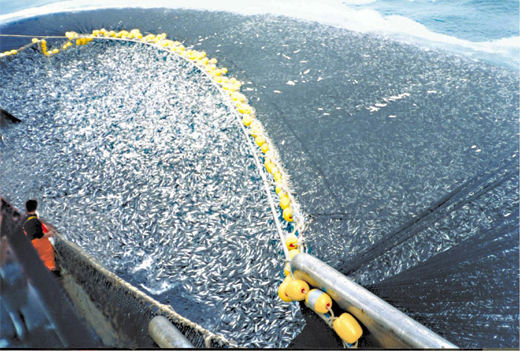Welcome to the Overfishing Learning Section

OVERFISHING - is the act whereby fish stocks are depleted to unacceptable levels, regardless of water body size. Resource depletion, low biological growth rates, and critical low biomass levels (e.g. by critical depensation growth properties) result from overfishing. For example, overfishing of sharks has led to the upset of entire marine ecosystems.
The ability of a fishery to recover from overfishing depends on whether the ecosystem's conditions are suitable for the recovery. Dramatic changes in species composition can result in an ecosystem shift, where other equilibrium energy flows involve species compositions different from those that had been present before the depletion of the original fish stock. For example, once trout have been overfished, carp might take over in a way that makes it impossible for the trout to re-establish a breeding population.
Examples of overfishing exist in areas such as the North Sea of Europe, the Grand Banks of North America and the East China Sea of Asia. In these locations, overfishing has not only proved disastrous to fish stocks but also to the fishing communities relying on the harvest. Like other extractive industries such as forestry and hunting, fisheries are susceptible to economic interaction between ownership or stewardship and sustainability, otherwise known as the tragedy of the commons.
The Peruvian coastal anchovy fisheries crashed in the 1970s after overfishing and an El Niño season largely depleted anchovies from its waters. Anchovies were a major natural resource in Peru; indeed, 1971 alone yielded 10.2 million metric tons of anchovies. However, the following five years saw the Peruvian fleet's catch amount to only about 4 million tons. This was a major loss to Peru's economy.
The collapse of the cod fishery off Newfoundland, and the 1992 decision by Canada to impose an indefinite moratorium on the Grand Banks, is a dramatic example of the consequences of overfishing.
The sole fisheries in the Irish Sea, the west English Channel, and other locations have become overfished to the point of virtual collapse, according to the UK government's official Biodiversity Action Plan. The United Kingdom has created elements within this plan to attempt to restore this fishery, but the expanding global human population and the expanding demand for fish has reached a point where demand for food threatens the stability of these fisheries, if not the species' survival.
Many deep sea fish are at risk, such as orange roughy, Patagonian toothfish, and sablefish. The deep sea is almost completely dark, near freezing and has little food. Deep sea fish grow slowly because of limited food, have slow metabolisms, low reproductive rates, and many don't reach breeding maturity for 30 to 40 years. A fillet of orange roughy at the store is probably at least 50 years old. Most deep sea fish are in international waters, where there are no legal protections. Most of these fish are caught by deep trawlers near seamounts, where they congregate because of food. Flash freezing allows the trawlers to work for days at a time, and modern fishfinders target the fish with ease.
Blue walleye went extinct in the Great Lakes in the 1980s. Until the middle of the 20th century, it was a commercially valuable fish, with about a half million tonnes being landed during the period from about 1880 to the late 1950s, when the populations collapsed, apparently through a combination of overfishing, anthropogenic eutrophication, and competition with the introduced rainbow smelt.
We ask you to please donate to the Big MaMa Earth Learning Academy an environmental solution based non-profit. Your donations will be utilized for continuing education and solutions for "Overfishing" and other important issues.
Please click the Icon’s below to view “Video’s” & “Photos”, review “Scientific Information” and be part of the “Solution”. “Your Future is NOW!”







